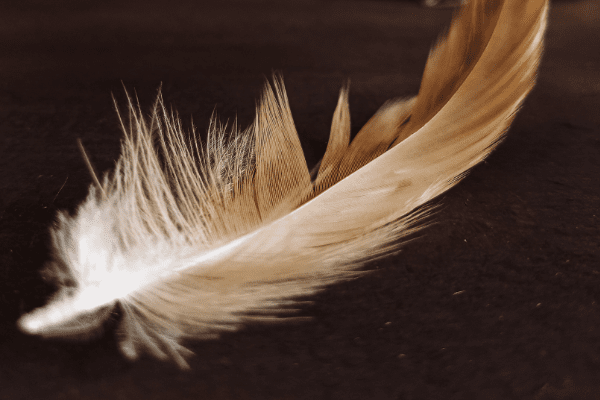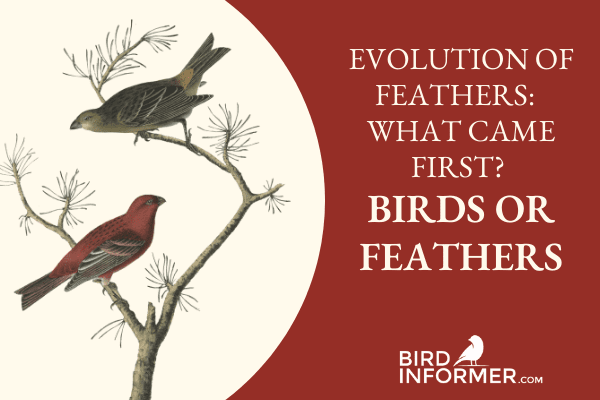Birds are known as the only animals that have feathers. It’s what makes them unique from all other animals. But would you believe that feathers actually came way before them?
Research suggests that feathers appeared 100 million years before birds. This means that they have come from the time of dinosaurs and have continuously evolved since.
In this article, we’re going to learn more about the origins of feathers and how they evolved through time. We’ll discuss:
- What are feathers?
- The origins of feathers
- Evolution of Feathers
- Bird evolution
- Facts About Feathers
- FAQs
If you’re interested to know more about these, read on…
What are Feathers?
Let’s start this discussion by defining first what feathers are.
Feathers, as mentioned earlier, are unique to birds and they serve as the birds’ outer covering. It’s generally made of keratin, the same lightweight material our fingernails are made of. At the base of each feather, muscles are attached so that birds can move them around conveniently.
They are impressive structures that are also flexible, strong, and colorful, which makes our favorite birds the beauty we know now. They come in an amazing array of types, and depending on where they are located in a bird, the shape varies.
So why are feathers very important to birds? Well, feathers have five main functions for birds:
- Insulation
- Waterproofing
- Display
- Flight
- Camouflage
This helps the birds survive day-to-day.
Flight allows them to travel to different places in search of food. Insulation helps protect them from the cold, particularly our water birds. Waterproofing keeps them dry so they can keep on flying. Display helps a lot with mating, and camouflage serves as a way they can hide from predators.
But because feathers came way before birds, we’re never sure if they served the same function 100 million years ago. Let us go back and find out more about the origins of feathers.
The Origins Of Feathers
While we see feathers nowadays as unique structures that help birds, birds are actually not the first creatures to have them.
Dinosaurs were actually first, although their feathers didn’t look like the feathers we know now. Based on the dinosaur fossils found in the past years, their feathers are more simple and have been dubbed by the scientific community as “dino fuzz”.
These feathers don’t work mainly for flying. They function as:
- Thermal insulation
- Communication
- Water repellency
And from this dino fuzz, the feathers evolved more until they finally became the flying feathers we see now.
Related article: Evolution of Beaks
The Evolution of Feathers
After careful study, scientists believed that feathers evolved through six different stages.
The first feathers were flexible hollow tubes. These are the feathers they found on dinosaur fossils or what we call the dino fuzz.
From the dino fuzz, the feathers evolved into clusters of hollow tubes or barbs. So from one dino fuzz, we now see several of them clustered or fused into one central shaft. Making the whole look fuzzier than the first.
Then we move to the next stage where side branches develop from each barb. These barbs are then fused together into one central shape, making them thicker. And from here is where the modern flight feathers came from.
From a messy-looking structure, the barbules developed hooks that interlocked together, creating a smoother surface. And this eventually evolved into a more asymmetric vane that supported avian flight. This is the kind of feather we can find in our modern birds.
But our modern birds are not the first creatures to have this kind of feather, too.
Speaking of Feathers…
Have you ever wondered why Hummingbird feathers look shiny and shimmery. Check out our article that does a deep dive into this topic. Click the button below…
Why Do Hummingbirds’ Feathers Shimmer?Evolution of Birds
One discovery in 1861 changed everything we believe about birds.
We all knew they came from dinosaurs and it was originally believed that feathers evolved from reptilian scales. But the discovery of a fossil, Archaeopteryx, in Germany changed everything
The Archaeopteryx lithographica is dubbed as the world’s earliest fossil bird. It is around the size of a magpie, and its characteristics are in between that of a reptile and a modern bird. Part of their avian characteristics that stood out is their feathers and other skeletal features that looked like it’s going through an evolving stage from reptiles to birds. It’s also found that their feathers look like on the last stages of the feather evolution, too.
Scientists believed that as soon as birds learned to fly, a few more developments occurred to their bodies. This includes an increase in muscle size for better wing control, tails grew shorter to assist with direction, and organs also evolved to keep up for better navigation, which includes better stamina and sight.
When the birds became stronger fliers, they traveled to many environments which led to the diversity that we see in birds now.

Facts About Feathers
- Feathers are unique only to birds. There may be many animals that fly, but none of them are feathered.
- Dinosaurs had a feathery fluff.
- The number of feathers in birds varies dramatically between bird species.
- Feathers can weigh more than a bird’s skeleton.
- Birds maneuver feathers via tiny muscles in their follicles.
- Birds replace their feathers regularly.
- Feathers get their colors in many ways. (1) via pigments – melanin, porphyrins, and carotenoids, and (2) via retracting light.
FAQs About The Origins Of Feathers
Did feathers evolve before birds?
Feathers are complex structures that were once believed to have evolved from reptilian scales. But upon further studies, it is found that feathers have evolved way before birds and even before avian flight.
When did feathers originate?
The earliest feathers are believed to be from the late Jurassic period. They started as filamentous feathers or fuzzy feathers and originated 100 million years, even before the avian flight. The only purpose of these feathers is for insulating the dinosaurs.
Final Thoughts On The Origins Of Feathers
To this day, there are still a lot of things that we don’t know about the origins of things. But careful research finally led us to some answers, and it finally became clear that the birds we know today are like our mini dinosaurs.
It’s possible that dinos can be as colorful and as cute as our modern birds. So, maybe the next time we’re admiring a bird’s plumage, let us think about where they originated, and it’s from dino fuzz.
References:
- https://www.britannica.com/animal/bird-animal/The-origin-of-feathers
- https://academy.allaboutbirds.org/features/all-about-feathers/#what-is-unique-to-birds.php
- https://www.nationalgeographic.com/magazine/article/feather-evolution

from BirdInformer.com https://ift.tt/nw3bxRP

No comments:
Post a Comment